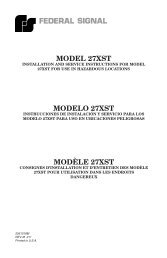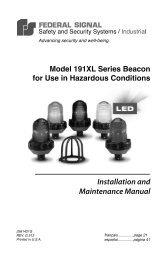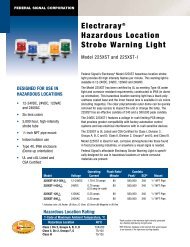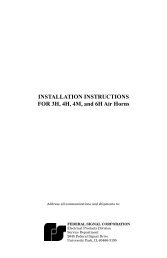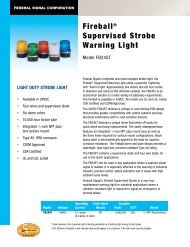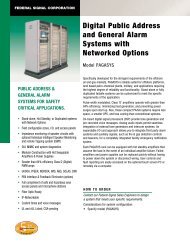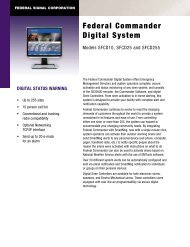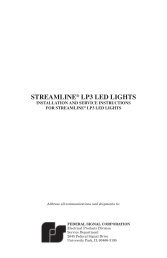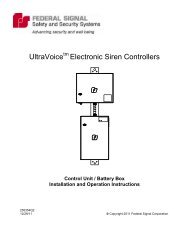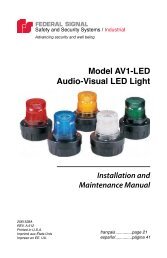MODEL 300MB-SD - Federal Signal
MODEL 300MB-SD - Federal Signal
MODEL 300MB-SD - Federal Signal
Create successful ePaper yourself
Turn your PDF publications into a flip-book with our unique Google optimized e-Paper software.
GROUND<br />
120/240 VAC<br />
10 1 GAIN 1716 1<br />
CNTR<br />
TB-2 TB-1<br />
AUDIO INPUT<br />
<strong>MODEL</strong> <strong>300MB</strong><br />
CENTRAL AMPLIFIER<br />
remote mic audio input level (16mVrms MAX.) for<br />
the 300VSC-1. Failure to adjust this level will cause<br />
distortion and clipping in the system.<br />
C. <strong>300MB</strong> Driving a 25Vrms Speaker Line<br />
(see figure 3-7).<br />
In this installation the CommCenter is directly<br />
driving a speaker or speakers, the total power<br />
consumed not exceeding the drive capability of a<br />
CommCenter.<br />
D. <strong>300MB</strong> Interfacing with a Central Amplified<br />
System (see figure 3-8).<br />
In this installation the CommCenter is<br />
acting as an audio input to a Central Amplifier. Message<br />
playback can be added to an existing Centrally<br />
Amplified Paging System.<br />
3-12. STORAGE CHIP INSTALLATION.<br />
NOTE<br />
The CommCenter accepts messages stored<br />
on ICs and pluggable circuit boards. Both are<br />
referred to as message chips in this manual.<br />
The messages stored on pluggable circuit<br />
boards will operate on all Series B, Series C,<br />
and Series D Models.<br />
The Series D CommCenters use a different<br />
storage IC than the Series A, Series B, and<br />
Series C. These ICs cannot be interchanged between<br />
Series A, Series, B, and Series C models.<br />
Make sure to specify which series CommCenter<br />
you have before ordering any additional<br />
messages.<br />
It is necessary to perform the procedures in<br />
this section ONLY if it is required to change<br />
the priority of the storage chips or adding a<br />
different message to the unit is required.<br />
The <strong>300MB</strong> can accommodate up to six storage<br />
chips. The CommCenter should be shipped from the<br />
factory with the storage chips installed. Each storage<br />
SIGNAL LINES<br />
SHIELDED<br />
TWISTED PAIR<br />
Figure 3-8. Model <strong>300MB</strong> with Central Amplifier Connections.<br />
3-7<br />
TB1-16<br />
TB1-17<br />
chip is marked with the Model Number and other<br />
information.<br />
Failure to follow all safety precautions and<br />
instructions may result in property damage<br />
serious injury, or death to you or others.<br />
Do not perform any installation or maintenance<br />
on this system when power is on.<br />
This device is to be installed by a trained electrician<br />
who is thoroughly familiar with the<br />
National Electrical Code and will follow the<br />
NEC guidelines as well as local codes.<br />
NOTE<br />
SIGNAL COMMON<br />
MIC. OUT<br />
TO ADDITIONAL SPEAKERS, 40 OHMS MAXIMUM LOAD<br />
290A2664-22B<br />
The Storage Chips and the CommCenter’s<br />
circuitry can be destroyed or damaged by<br />
static discharge. Observe anti-static procedures<br />
when installing or servicing a<br />
CommCenter.<br />
Storage Chips should be installed starting at<br />
Priority Tone 1 and working downward. If, for example,<br />
only four messages are required, have PT1<br />
through PT4 sockets occupied and leave PT5 and PT6<br />
open.<br />
To remove a storage chip gently pry it out of its<br />
socket. To install the storage chips insert them into<br />
the desired sockets on the printed circuit board as<br />
shown in figure 1-3. Ensure that the notch on the<br />
edge of the new storage chip is facing in the same<br />
direction as the old one (next to the resistors at the<br />
edge of the board) and that all pins are properly inserted<br />
in the socket—not bent under.<br />
Test the CommCenter after any maintenance<br />
is performed.



